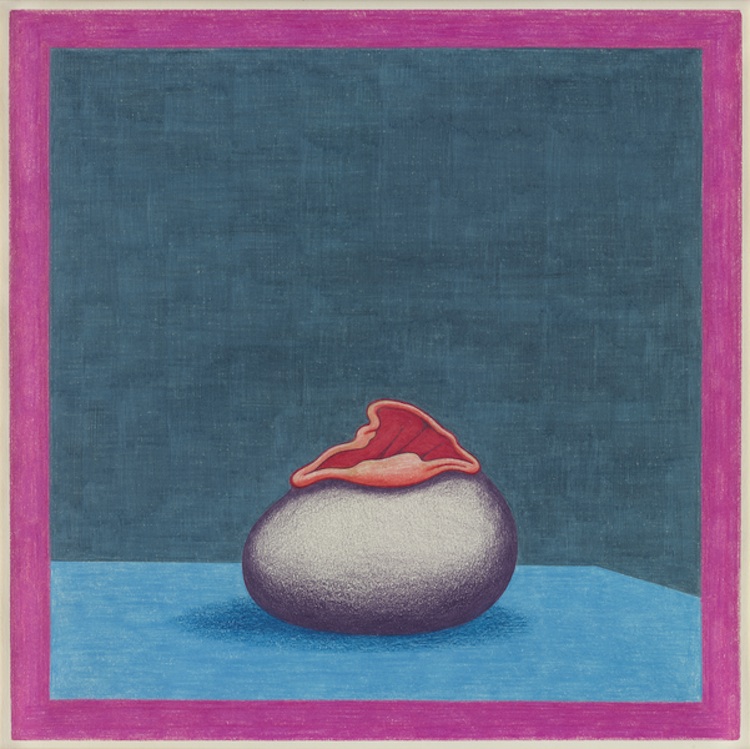LOS ANGELES — We’ve run a couple articles about the drawings of ceramics legend Ken Price. Way back at the dawn of CFile we profiled the show Ken Price: Slow and Easy Wins the Race at The Drawing Center in New York, an exhibition Chief CFile Editor Garth Clark called “an intense pleasure.” Later on, we revisited Price’s drawings again with an ultra-rare look at his erotic vessels. Fascinating stuff all around.

Ken Price, Specimens on Pillow Bases, 1965, graphite, acrylic and colored pencil on paper, 11 3/4 x 12 3/4 inches

(Left) Ken Price, Japanese Figurine Cup, 1969, acrylic and silkscreen on board, 14 x 11 inches. (Right) Ken Price, Study for Chinese Figurine Cup, 1969, acrylic, graphite and ink over lithograph and screenprint on board, 22 x 18 inches
We’re pleased to have another chance to see more of Price’s work. Over the summer The Matthew Marks Gallery in LA held Ken Price: Drawings (Los Angeles, July 9 – September 10). The exhibition featured 34 drawings from Price’s estate and many of these were on view for the first time. The drawings were supported by five of Price’s sculptures. The gallery states:
“I’ve been drawing since I can remember,” Price has said. “I think sculptors learn to draw so that they can see what they’ve been visualizing.” His earliest works on paper explore forms and colors for his abstract sculptures, as seen in the Specimen drawings of the early 1960s. Price also drew impossible objects, like cups with a leaping frog or a cavorting nude for a handle. In his drawings of the late 1960s and early 1970s, the imaginary spaces inhabited by these objects became more fully realized, as in Coffee Shop at the Chicago Art Institute (1971).
Price’s drawings provide a counterpoint to his sculptures while imagining a world they might inhabit. Two Sofas (1991), for example, shows an imaginary domestic interior with a view of anonymous downtown high-rises. A semi-fictional Los Angeles appears in several drawings, complete with clogged freeways and palm-studded skylines.
Nature became the dominant force in the drawings from the early 2000s, which feature erupting volcanoes and turbulent seas inspired by Price’s trips to Hawaii. After his 2002 move to Taos, New Mexico, Price focused more on the high-desert scenery of rocky outcroppings, dramatic sunsets, and isolated trailer homes. He also began depicting his sculptural forms in nature, re-imagining them as monumental figures in the primordial landscape. The effect is both comic and mysterious, like his sculptures themselves — embodying, in the words of Lucy Lippard, “a beautiful and rather horrible strangeness that appeals to both the mind and the senses.”

Ken Price, Untitled (Geometric Cup and Interior), 1980, acrylic and graphite on board, 20 x 23 inches

Ken Price, Death Shrine, 1975, graphite and acrylic on board, 9 x 11 inches. Click to see a larger image.
Writing for the Los Angeles Times, David Pagel said the exhibition was “an intimate affair.” He said the remarkable thing about the show was that the drawings have the “presence” of portraits, conveying a 3D reality through a two-dimensional image.
“The best portraits capture an essential facet of their subjects while suggesting that many other facets lie just beneath the surface — that life, in all its impossible-to-depict richness, is present.
That is the sense you get from Price’s drawings. You also see that he treated his sculptures as autonomous beings — as complex creatures that have lives of their own.”

Ken Price, Two Sofas, 1991, acrylic and ink on paper, 12 x 25 7/8 inches. Click to see a larger image.

Ken Price, Interior, 1994, ink and colored pencil on paper, 20 3/8 x 26 inches. Click to see a larger image.
The sculptures on view highlight an important point about Price’s relationship to sculpture and drawing: they inform each other. This is from a review by D. Creahan from Art Observed:
“Price’s drawings here elaborate on the complex interior world that the artist seems to have built around or perhaps in complement to, his sculptures. In one work Where Women Rule, a group of nude females cavort around a large, undulating form, as if worshipping the object’s twists and curves. The object looks as if it had been drawn straight from Price’s studio, or perhaps was preparing itself to leap from the page and into the gallery space. This relationship is reinforced in the second room of the space, where a single sculpture works in conjunction with a series of hung drawing, as if the space Price had created was designed to work as a series of reinforced shapes and forms, alternating between imagined worlds and concrete objects.”
Do you love or loathe these works of contemporary (not quite) ceramic art? Let us know in the comments.







Add your valued opinion to this post.